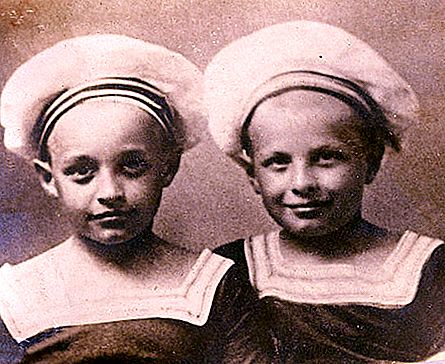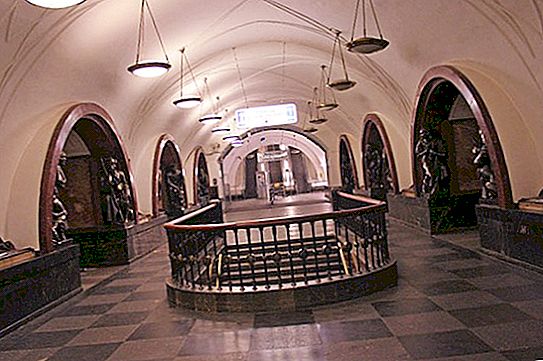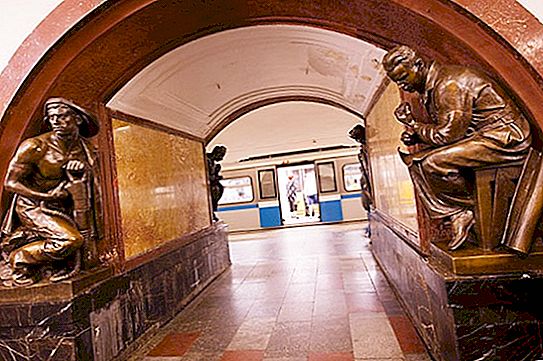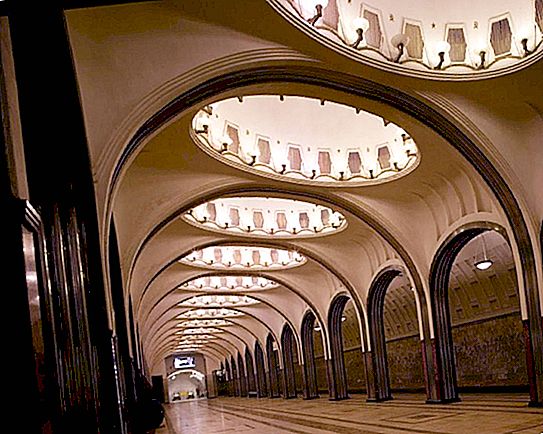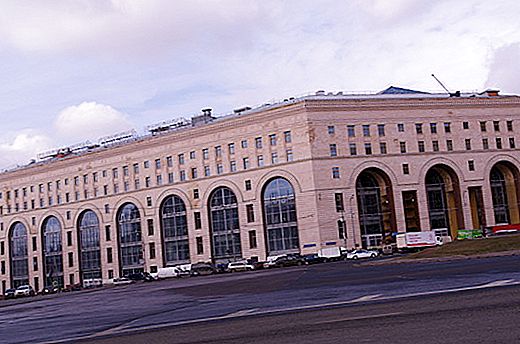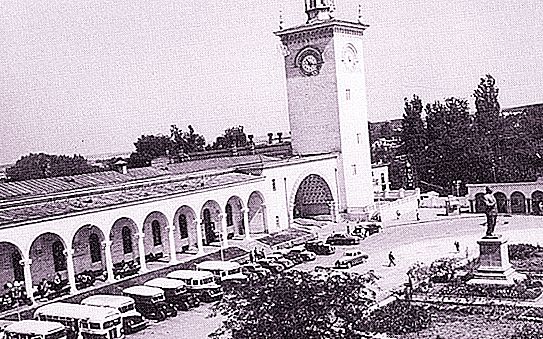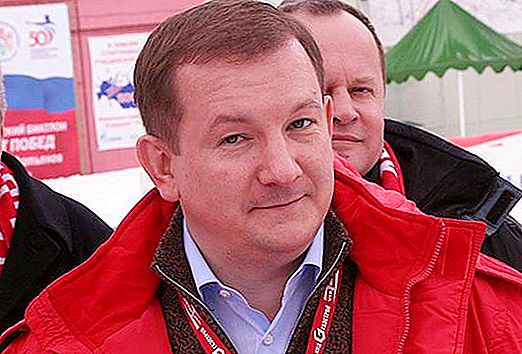The outstanding Soviet architect Dushkin Alexei Nikolaevich left a great legacy and had a significant impact on domestic architecture and urban planning. His life was not easy, but he was able to realize his talent. We will tell you how the architect A. N. Dushkin was formed, what he is famous for, how his creative biography and personal life took shape.
Family and childhood
On the Christmas Eve of 1904, in the village of Aleksandrovka, Kharkov province, a boy was born, the future architect Dushkin. The biography began with a holiday, but the life of Alexei Nikolaevich was not always full of joyful events - it is full of dramatic stories. But then everything was perfect. The family in which Alex was born was from an intelligent circle. Mom came from among Russified Germans from Switzerland, her name was Nadezhda Vladimirovna Fichter. Father Nikolai Alekseevich was a rather famous soil scientist, worked as an agronomist and manager of the estates of a large industrialist, sugar factory, philanthropist P.I. Kharitonenko and the estates of the Kening family. The father of the future architect was born in Vologda and was a hereditary honorary citizen of this city. The atmosphere in the family was very friendly, cultural, many interesting, educated people visited the house.
Alexei had an older brother Nikolai, who later became a writer and artist. A completely different fate awaited him. At the age of 18, his brother began to serve in the tsarist army, went with her all of Eastern Europe, received a military award - the Order of St. George. He never returned to Russia, since 1926 he lived in France, where he gained great fame as a miniature painter. The brothers have never met again since their early youth.
Alexey’s childhood was more than prosperous: an educated, happy family, friendly children, a tutor, an interesting atmosphere. All this allowed children to develop harmoniously.
Education
In tsarist Russia, it was customary in wealthy families to give their children a home education, and the family of the architect Dushkin was no exception. The boy’s biography was laid in the house, where a special teacher was hired for the brothers, who taught them the basics of all sciences. This allowed the young man to easily enter a good school without taking a course at the gymnasium.
At the end of the school, Alexei, at the insistence of his father, enters the reclamation institute in Kharkov. But the young man did not feel a call to agriculture. In 1923, he transferred to the Faculty of Chemistry, but he did not stay here for long either. In 1925, immediately after the death of his father, he was transferred to the Faculty of Civil Engineering. And then he achieves that he is accepted into the workshop of the famous Ukrainian architect Aleksey Nikolayevich Beketov.
The diploma project “Building of the Printers' Combine” of Dushkin was accepted by the mentors supportive. In 1930, he completed his studies, but Alexey Nikolayevich never received a document on graduation because of the impossibility or unwillingness to liquidate the debt in the Ukrainian language.
Carier start
After graduating from the institute, the architect Dushkin was assigned to work in Kharkov Giprogor. The beginning of his career is connected with constructivism. He came under the strong creative influence of the famous Soviet architects Leonid, Alexander and Victor Vesnins. In 1933, he got a job in the workshop of Ivan Alexandrovich Fomin, where he was fond of the art deco aesthetics. During this period, he worked in a team on projects for a new environment in the city of Donbass, the building of the Road Institute in Kharkov. During this period, Dushkin actively participated in various competitions to declare his vision of modern architecture. Among the most notable projects: the Radio Palace, the Institute of Marx-Engels-Lenin, the Academic Cinema in the capital of the USSR. In them, Dushkin was part of the team, but so far not the leader of the team. Together with Y. Doditsa, he made a project for the club of railway workers in Debaltseve, for which reason the team was awarded the first prize.
Palace of Soviets
In 1931, the All-Union Competition for the project of the Palace of Soviets was held in Moscow. This grandiose plan has been hatched by the country's leadership since the beginning of the 20s. The competition task was large-scale: several thousand people should be placed in the building, there should be Big and Small halls. In addition, the appearance of the building should prove the triumph of socialism as the best ideology in the world. Architect Aleksey Dushkin, as part of a group of Yakov Nikolaevich Doditsa, took part in preparing the project for this competition. The project under the slogan “Chervonny Prapor” received the first prize, its creators were awarded the sum of 10 thousand rubles, but the project was not accepted for implementation.
In total, 160 works were submitted to the competition, including from the famous architects Le Corbusier and Gropius. The competition revealed many talented architects and generated many bright ideas, but not one of them was accepted for implementation. However, for Dushkin it was a chance to receive orders in which he was able to realize his talent. He also met with outstanding contemporary architects Shchusev and Zholtovsky. In addition, thanks to this project, Dushkin and his family moved to Moscow.
Subway
The main achievement of Dushkin is the creation of projects for Moscow metro stations. In 1934, the architect began work on the project of the Palace of Soviets station (now Kropotkinskaya). The work was not easy: Dushkin had to prove the legitimacy and value of his plan at all levels. The project used the latest technology for casting concrete columns. Today, their forms are striking in the elegance of lines and conciseness.
This station literally saved the architect's life. In early March 1935 he was arrested and sent to Butyrka: the NKVD had some complaints against him. But on March 15, the station opened, a foreign delegation arrived to see it. They wished to get acquainted with the author, which skillfully took advantage of the wife of Dushkin, who wrote a letter to the government. Three days later, the architect was released, but this story forever left a mark on his soul. Dushkin was allowed to return to work and he created a number of other great projects, these are the stations: Ploshchad Revolyutsii, Mayakovskaya, Avtozavodskaya (at that time Stalin Plant), Novoslobodskaya, Paveletskaya (radial). These projects are widely known not only in Russia, but throughout the world. Mayakovskaya station even won the Grand Prix at the World Exhibition in New York in 1939.
In addition, Alexei Nikolaevich raised a galaxy of followers who created stations not only in Moscow, but throughout the Soviet Union. His school was even called movement architecture. The main principles justified by Dushkin are:
- the need to clearly identify the basis of the design, doing without unnecessary volumes,
- the use of light as a means of forming an architectural image,
- unity of architectural design with decor,
- reliable floors.
Main projects
But the architect Dushkin, whose work at the Ministry of Railways was widely known, continued to create ground buildings. His legacy includes the buildings of the USSR embassies in Bucharest and Kabul, a high-rise building in Moscow at the Red Gate, the famous building of the Children's World on Lubyanka Square.
Innovation
The architect Dushkin earned his fame not only for his ability to create beautiful buildings, but also for his serious contribution to the practice of urban planning. He worked a lot with communication lines, designed bridges and train stations and realized that the building should not only impress with external effects, but be functional. He always skillfully combined the beauty of the decor with the general theme of the structure and high-quality constructive.
Work in the Ministry of Railways
In the 1950s, practitioners from various industries came to work in many ministries. The architect Dushkin did not pass this fate. Photos of his works can be found in many directories of the world on the arrangement of the subway. He was invited to the post of architect at Metroproject. Then he quickly goes up the career ladder, first taking the post of head of the architectural department of the Metroproject, and then - the chief architect of the workshop at the Ministry of Railways.
He also works in parallel on a number of station buildings. First, he draws up portals on the railway line Sochi - Adler - Sukhumi. After the war, he creates station designs in Stalingrad, Yevpatoriya, Sevastopol. He takes an active part in the restoration of railways after the Second World War. In the period from the late 30s to 1956, he worked very hard and hard. Under his leadership, many stations and stations are opened in the southern part of the USSR. And in 1956 he was removed from the post of chief architect of Mosgiprotrans, and a year later removed from architectural supervision of all projects.
Persecution
In the time of N. S. Khrushchev, the struggle against cosmopolitanism began, and many talented artists, including the architect Dushkin, fell under this campaign. The wife of Aleksey Nikolaevich recalled that in 1957, in the prime of his creative powers, he was thrown out of architecture. Back in 1956, they began to make claims against him on the part of party and trade union bodies. We can say that this was the beginning of the discredit of the architect. In 1957, as a result of prolonged torment caused by the Decree "On eliminating excesses in design and construction" of 1955, Dushkin was removed from all projects and removed from all posts. This was a great stress for the architect.
Way out of the crisis
Dushkin, after he had to part with the great architecture, began to devote himself more to painting, which previously served only as a hobby. He also begins to work in monumental sculpture, creates monuments in Saransk, Vladimir, the monument to Gagarin in Moscow in tandem with the sculptor Bondarenko, the Victory Monument in Novgorod. Dushkin makes several gravestones (to Stanislavsky, Eisenstein), which can be seen at the Novodevichy cemetery.
In 1959, he came to work at Metrogiprotrans as chief architect. In the early 60s he was attracted to work on projects of metro lines in Leningrad, Tbilisi, Baku, but he was not allowed to lead the author’s projects. In 1966, he suffers a microinfarction, but continues to work. In 1976, Dushkin began to write a book about his work, but did not have time to finish it.
Teaching activities
In 1947, the architect Dushkin began to work with students of the Moscow Architectural Institute. Here he worked until 1974. Over the years, he released many architects who continued to carry his ideas.
Awards
For his busy creative life, the architect Dushkin received an unfortunate few awards. On his account three Stalin Prizes (for the metro station and for the high-rise project in Moscow). He was also awarded the Order of Lenin and twice received the Order of the Red Banner of Labor. The architect has several professional awards.
Personal life
Even in early youth, the architect Dushkin, whose wife and children were not yet in priority plans, met Tamara Dmitrievna Ketkhudova. She was at that time a student at the conservatory. Her father was a well-known construction engineer, a graduate of the St. Petersburg Engineering Institute. Three years later, in 1927, the young people got married. The young began to live in the house of Tamara's parents in Kharkov. They spent their honeymoon in Kichkas, where Alex had practice.
In 1928, the couple had a son, Oleg. In 1940, the second son Dmitry was born at the Dushkins. From 1941 to 1945, many Muscovites were sent to evacuate, Dushkin’s wife and children left for Sverdlovsk, and the architect remained in the capital throughout the war and worked hard.
On June 5, 1977, the Dushkins celebrated a golden wedding, their life was a strong union in which the wife always and in every way supported her husband. And he heard music in her and embodied it in his buildings. All researchers note this particular musicality of architecture of Dushkin. October 1, 1977 the life of Alexei Nikolayevich was cut short by a heart attack. Tamara Dmitrievna survived her husband for 22 years, and all these years she carefully preserved her husband’s heritage, tried to popularize him.
